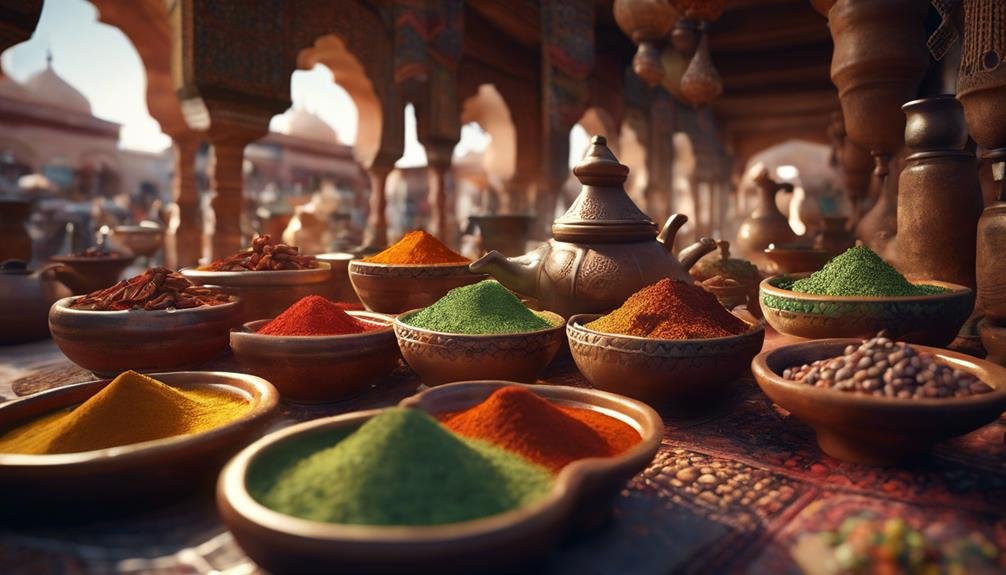Step into the flavorful world of traditional Moroccan cuisine, a culinary journey shaped by centuries of history and cultural influences. Explore unique dishes passed down through generations, boasting a delightful mix of flavors and exotic ingredients. Discover the fusion of Mediterranean, Arabic, and African culinary styles that create iconic Moroccan delicacies. Experience the art of slow cooking, vibrant spice blends, and communal dining customs that define this rich gastronomic tradition. Each bite tells a story of cultural exchange and culinary evolution, inviting you to savor the tastes of Morocco's diverse heritage.
Key Takeaways
- Moroccan cuisine reflects centuries-old history and diverse cultural influences.
- Traditional recipes passed down through generations shape the unique flavors.
- Fusion of Berber, Arab, and Mediterranean culinary traditions creates iconic dishes.
- Use of flavorful spice blends, slow cooking methods, and locally sourced ingredients.
- Regional variations showcase influences like coastal seafood, Spanish flavors, and Berber influences.
History of Moroccan Cuisine
Moroccan cuisine traces its roots back centuries, evolving through a rich tapestry of cultural influences and culinary traditions. The culinary evolution of Moroccan cuisine is a fascinating journey that reflects the country's diverse history. Traditional recipes have been passed down through generations, each one telling a story of the people who created them.
One of the key aspects of Moroccan culinary evolution is the blending of Arab, Berber, Moorish, and Mediterranean influences. These diverse cultural influences have contributed to the unique flavors and ingredients found in Moroccan dishes. Traditional recipes often feature a harmonious combination of sweet and savory flavors, such as the iconic tagines made with tender meat, dried fruits, and aromatic spices.
Over the centuries, Moroccan cuisine has been shaped by trade routes, conquests, and migrations, resulting in a rich and varied culinary landscape. From the bustling markets of Marrakech to the coastal towns of Essaouira, traditional Moroccan recipes continue to be cherished and celebrated as a reflection of the country's vibrant food culture.
Influences on Moroccan Culinary Traditions
Moroccan culinary traditions have been shaped by a rich tapestry of influences, creating a unique blend of flavors and techniques.
The historical impact of trade routes has introduced new ingredients and cooking methods to Moroccan cuisine over the centuries.
This fusion of cultural influences and the availability of diverse local ingredients have given Moroccan dishes their distinctive and celebrated taste.
Cultural Fusion in Cuisine
Incorporating a rich tapestry of influences from various cultures, Moroccan culinary traditions showcase a unique blend of flavors and techniques that have evolved over centuries. The fusion cuisine in Morocco is a result of cultural exchange through centuries of interactions with different civilizations. Traditional ingredients like couscous, preserved lemons, and various spices are used with a modern twist to create innovative dishes that still hold true to their roots. This blending of old and new culinary practices has led to the creation of iconic Moroccan dishes like tagine, bastilla, and harira, which reflect the country's diverse heritage. The table below highlights some key influences on Moroccan cuisine:
| Influences | Examples |
|---|---|
| Berber | Couscous |
| Arab | Tagine |
| Andalusian | Pastilla |
| French | Moroccan pastries |
Historical Trade Impact
Through centuries of trade interactions, diverse cultures have left a lasting impact on the evolution of Moroccan culinary traditions. Morocco, strategically located at the crossroads of ancient trade routes linking Africa, Europe, and the Middle East, has been a melting pot of culinary influences. The cultural exchange along these trade routes introduced new ingredients, cooking techniques, and spices to Moroccan cuisine.
The Berbers, Arabs, Moors, and Ottomans all contributed to the rich tapestry of flavors found in traditional Moroccan dishes. Ingredients like saffron, cinnamon, and dried fruits arrived through these trade networks, transforming local recipes. Additionally, the blending of Mediterranean, Arabic, and African cooking styles has created the unique and vibrant gastronomy that defines Moroccan cuisine today.
Local Ingredient Diversity
The fusion of indigenous Berber ingredients with imported culinary influences has intricately shaped the diverse local ingredient palette defining traditional Moroccan culinary traditions. Moroccan cuisine is a vibrant tapestry woven with a variety of flavors and textures, all stemming from the rich diversity of ingredients sourced locally and from afar.
Here are four key elements contributing to the local ingredient diversity in Moroccan cuisine:
- Ingredient Sourcing: Moroccan dishes are a reflection of the country's diverse landscapes, with ingredients like saffron from Taliouine and olives from Meknes adding significance to the cuisine.
- Culinary Techniques: Traditional cooking methods such as slow-cooking in clay pots and the use of intricate spice blends play an essential role in enhancing the flavors of local produce.
- Local Produce: From the sweetness of dates to the earthiness of cumin, Moroccan cuisine celebrates the abundance of locally grown fruits, vegetables, and spices.
- Traditional Flavors: The use of preserved lemons, argan oil, and harissa showcases the traditional flavors that have been passed down through generations.
Key Ingredients in Moroccan Dishes
Moroccan cuisine is renowned for its rich blend of flavors, largely attributed to the use of popular spices such as cumin, paprika, and cinnamon. Understanding essential cooking techniques like slow cooking in a tagine or charbroiling over open flames is key to mastering traditional Moroccan dishes.
These key ingredients and techniques have been passed down through generations, shaping the unique culinary identity of Morocco.
Popular Moroccan Spices
Exploring the vibrant culinary landscape of Morocco reveals a rich tapestry of flavors woven together by the use of various popular spices.
- Cumin: This earthy spice is a staple in Moroccan cuisine, adding depth and warmth to dishes like tagines and couscous.
- Paprika: Whether sweet or hot, paprika is used to add color and a subtle kick to many traditional Moroccan dishes.
- Cinnamon: A key ingredient in both savory and sweet dishes, cinnamon lends a warm and aromatic flavor to Moroccan cuisine.
- Ginger: Known for its unique zing, ginger is often used to infuse dishes with a fresh and slightly spicy flavor, balancing out the richness of other ingredients.
These spices, often found in bustling spice markets, contribute to the diverse and complex flavor profiles that define Moroccan cooking.
Essential Cooking Techniques
Delving into the culinary traditions of Morocco reveals a meticulous blend of essential cooking techniques that form the foundation of the country's iconic dishes. Traditional Moroccan cooking relies heavily on slow cooking methods such as braising, stewing, and simmering. These techniques allow the flavors of the spices and ingredients to meld together over time, creating rich and complex taste profiles.
Tagines, a popular cooking vessel, are frequently used to slow-cook meats, vegetables, and fruits, infusing them with authentic Moroccan flavors. Another essential technique is the art of preserving ingredients through methods like pickling, drying, and curing, which have been integral to Moroccan cuisine for centuries. By mastering these cooking techniques, you can truly capture the essence of Traditional Moroccan Cooking in your dishes.
Signature Dishes of Morocco
Indulge in the rich tapestry of flavors that define the culinary heritage of Morocco through its enchanting signature dishes.
Explore the vibrant Moroccan street food scene, where savory pastries like the famous meat or vegetable-filled pastilla tantalize your taste buds.
Delight in the aroma of tagines, slow-cooked stews that blend tender meats with a symphony of spices and dried fruits, creating a harmonious balance of flavors.
Savor the delicate flavors of couscous, a staple dish that showcases the art of steaming semolina grains to perfection, often accompanied by a hearty vegetable or meat-based stew.
Finish your culinary journey with Moroccan dessert specialties such as the decadent almond and honey-filled pastries known as chebakia, or the invigorating sweetness of a bowl of orange blossom water-infused fruit salad.
Each dish tells a story of Morocco's diverse cultural influences, from Berber to Arab, leaving a lasting impression on every palate it graces.
Culinary Techniques in Moroccan Cooking
When preparing Moroccan dishes, you'll find that flavorful spice blends play a vital role in creating the rich and aromatic flavors characteristic of the cuisine.
Traditional Moroccan cooking often involves slow cooking methods, allowing the ingredients to meld together and develop complex tastes.
Freshness is highly valued in Moroccan culinary techniques, as using high-quality, locally sourced ingredients is key to achieving the authentic and vibrant flavors of the dishes.
Flavorful Spice Blends
Exploring the culinary heritage of Morocco reveals a rich tapestry of flavorful spice blends that are integral to traditional Moroccan cooking techniques. These blends are carefully crafted to enhance the taste and aroma of dishes, creating a symphony of flavors that delight the senses.
Here are four key elements that contribute to the unique spice blends in Moroccan cuisine:
- Ras el Hanout: This complex blend can contain up to 30 different spices, including cinnamon, cumin, ginger, and more, offering a depth of flavor.
- Harissa: A fiery blend of chili peppers, garlic, cumin, coriander, and caraway seeds, adding a spicy kick to dishes.
- Baharat: A versatile mix of black pepper, cumin, coriander, and cinnamon, used in both savory and sweet dishes.
- Chermoula: A zesty blend of herbs like coriander and parsley, mixed with garlic, cumin, and paprika, commonly used as a marinade for fish and meat dishes.
Slow Cooking Methods
Slow cooking methods have long been an essential aspect of traditional Moroccan culinary techniques, infusing dishes with deep, rich flavors and tender textures. In Moroccan cuisine, flavorful tagine recipes and slow-cooked stews are emblematic of this cooking style.
Tagine dishes are named after the earthenware pot they're cooked in, allowing the ingredients to simmer slowly over low heat, melding together to create aromatic and complex flavors. The slow cooking process tenderizes tough cuts of meat, while also enhancing the spices and seasonings used in the dish.
Moroccan stews, such as the famous lamb or chicken-based options, benefit greatly from this technique, resulting in succulent meat and vegetables infused with the essence of the spices and herbs used.
Importance of Freshness
In traditional Moroccan cuisine, the importance of freshness lies at the heart of culinary techniques, ensuring vibrant flavors and peak quality in each dish prepared.
Here are four key ways freshness is emphasized in Moroccan cooking:
- Seasonal ingredients: Moroccan cuisine thrives on using seasonal produce to enhance the flavors of each dish, ensuring a harmonious blend of tastes.
- Sustainability: By prioritizing seasonal ingredients, Moroccan cuisine promotes sustainability by reducing the need for out-of-season imports.
- Farm to table: Emphasizing farm-to-table practices, Moroccan chefs source their ingredients directly from local producers, guaranteeing freshness and supporting the community.
- Organic sourcing: Many traditional Moroccan recipes rely on organically sourced ingredients, free from pesticides and chemicals, to maintain the integrity of the flavors and the health benefits of the dishes.
Importance of Spices in Moroccan Cuisine
Spices play an essential role in enhancing the rich flavors and aromas found in traditional Moroccan cuisine. The art of spice pairing is deeply ingrained in Moroccan culinary traditions, with combinations carefully selected to create a harmonious blend of flavors. Cumin, paprika, cinnamon, ginger, and saffron are just a few of the key spices that form the foundation of Moroccan dishes, each contributing its unique essence to the overall taste profile.
Moroccan cuisine is renowned for its complex flavor profiles, achieved through the skillful use of various spices. Cumin adds earthiness, paprika brings a subtle heat, cinnamon imparts a sweet warmth, ginger provides a spicy kick, and saffron lends a luxurious touch. These spices aren't only about adding taste but also about creating a sensory experience that transports you to the vibrant streets of Marrakech or the bustling markets of Fez.
Understanding the importance of spices in Moroccan cuisine goes beyond just seasoning food; it's about preserving culinary heritage and paying homage to centuries-old traditions that have shaped the country's gastronomic identity. The careful balance of spices in Moroccan dishes reflects a deep-rooted appreciation for the culinary arts and the cultural significance of food in Moroccan society.
Traditional Moroccan Dining Customs
Traditional Moroccan dining customs reflect a profound connection to cultural heritage and social rituals, embodying a blend of history, tradition, and community values. Moroccan dining etiquette and traditional meal rituals are deeply ingrained in the fabric of daily life, fostering a sense of togetherness and shared experiences.
Here are four key elements that characterize traditional Moroccan dining customs:
- Handwashing Ritual: Before meals, Moroccans traditionally perform a handwashing ceremony known as 'Ablution,' symbolizing cleanliness and purification before engaging in the act of eating.
- Communal Dining: Meals are often shared from a central dish, such as a tagine, emphasizing the importance of community and togetherness during mealtime.
- Hospitality: Moroccan hospitality plays a central role in dining customs, with hosts going to great lengths to make guests feel welcomed and well-fed.
- Use of Bread: Bread, particularly round loaves of Khobz, is a staple at the Moroccan table, used for scooping up stews and sauces, symbolizing sustenance and unity.
Regional Variations in Moroccan Cooking
Discovering the diverse regions of Morocco reveals a rich tapestry of culinary traditions and flavors that contribute to the vibrant mosaic of Moroccan cuisine. Regional influences play a significant role in shaping the diverse culinary landscape of Morocco.
In the coastal regions, such as Casablanca and Essaouira, seafood dishes are prominent due to easy access to the ocean. The northern region, including cities like Chefchaouen and Tetouan, showcases Spanish and Mediterranean influences, incorporating ingredients like olives and citrus fruits into their dishes.
Moving towards the interior, cities like Fez and Meknes are known for their rich and flavorful tagines, often prepared with dried fruits and aromatic spices. In the south, near the Sahara Desert, dishes like couscous with raisins and almonds are popular, reflecting the nomadic Berber influences of the region.
The diverse landscapes and cultural influences in Morocco have led to a culinary diversity that's both intriguing and delicious.
Health Benefits of Moroccan Foods
Exploring the nutritional aspects of Moroccan cuisine reveals a rich tapestry of health benefits woven through the diverse flavors and ingredients of the traditional dishes. Moroccan foods offer a unique blend of taste and wellness, making them not only delicious but also beneficial for your health. Here are four key reasons why Moroccan cuisine stands out for its health advantages:
- Rich in antioxidants: Moroccan dishes are often packed with ingredients like cumin, cinnamon, and turmeric, which are known for their antioxidant properties, helping to combat inflammation and oxidative stress in the body.
- High in fiber: With staple ingredients like lentils, chickpeas, and whole grains, Moroccan cuisine is a great source of dietary fiber, promoting digestive health and contributing to a feeling of fullness.
- Heart-healthy fats: Olive oil, a common ingredient in Moroccan cooking, is a source of monounsaturated fats that can help lower bad cholesterol levels, reducing the risk of heart disease.
- Balanced and varied: Moroccan meals typically include a variety of food groups, ensuring a good balance of nutrients and a diverse array of vitamins and minerals for overall health and well-being.
Popular Beverages in Moroccan Culture
Exploring Moroccan culture reveals a captivating array of popular beverages that have played significant roles in traditional gatherings and daily life. Tea culture is deeply ingrained in Moroccan society, with mint tea being a staple in social settings and a symbol of hospitality. This sweet and invigorating drink is typically served in small glasses and poured from a height to create a frothy top, showcasing the host's skills and respect for the guests.
Morocco's beverage traditions extend beyond tea to include other unique drinks like spiced coffee, known as 'nus-nus,' which blends equal parts coffee and milk for a rich and aromatic experience. Additionally, 'jus d'orange,' or orange juice, is a popular choice due to Morocco's abundant citrus fruits.
Here is a glimpse of some popular beverages in Moroccan culture:
| Beverage | Description | Occasions |
|---|---|---|
| Mint Tea | Sweet and invigorating tea | Social gatherings |
| Nus-Nus | Spiced coffee with milk | Morning rituals |
| Jus d'orange | Freshly squeezed orange juice | Breakfast |
Conclusion
To sum up, traditional Moroccan cuisine is a vibrant tapestry of flavors and influences that have been shaped by centuries of history and cultural exchange.
Like a colorful mosaic, Moroccan dishes blend aromatic spices, fresh herbs, and hearty ingredients to create a culinary experience that's both rich in taste and steeped in tradition.
From the bustling markets of Marrakech to the coastal towns of Essaouira, the diverse regional variations in Moroccan cooking offer a unique glimpse into the country's culinary heritage.

The Editorial Team is a passionate group of Morocco enthusiasts dedicated to sharing the beauty, culture, and wonders of this captivating country. With diverse backgrounds and a deep love for travel, we strive to bring you engaging and informative content that inspires your Moroccan adventures. From uncovering hidden gems and sharing local insights to exploring mouthwatering cuisine and showcasing the vibrant lifestyle, our team is committed to providing you with valuable resources and exciting stories that enhance your exploration of Morocco. Join us on this journey as we celebrate the rich heritage and unforgettable experiences that make Morocco truly special.







